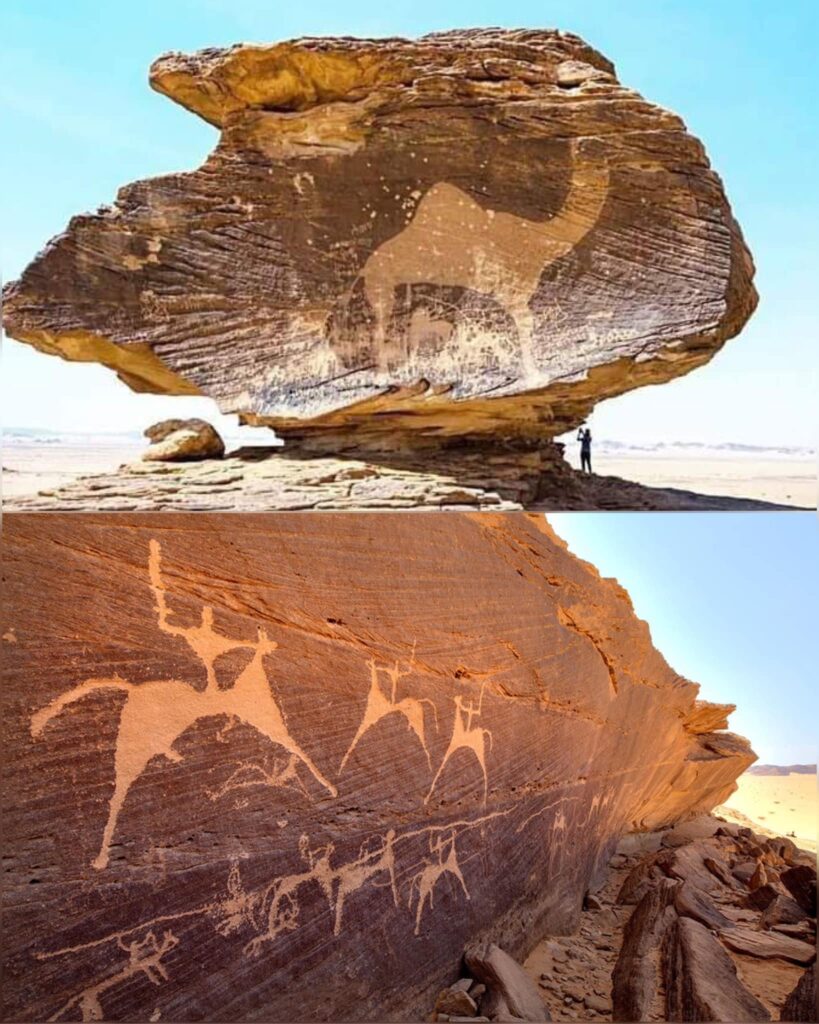Bi’r Hima, situated in the heart of southwestern Saudi Arabia, is one of the world’s most profound archaeological sites, home to an astonishing collection of ancient rock art and inscriptions. Spanning 7,000 years, this UNESCO World Heritage site offers a unique glimpse into the lives, beliefs, and daily routines of ancient Arabian communities. Far more than a mere gallery of petroglyphs, Bi’r Hima serves as an enduring testament to a flourishing culture where art, survival, and spirituality intermingled in the ancient desert landscape.
The Richness of Bi’r Hima’s Rock Art
The rock art at Bi’r Hima features images of camels, ibexes, ostriches, and even lions, hinting at a distant past when the area was more verdant and capable of sustaining a diverse range of wildlife. These images depict not only the animals themselves but also the interactions between humans and animals, showing hunting scenes, pastoral activities, and the tools used by these ancient societies. This preservation of everyday life carved into stone gives researchers a powerful tool to reconstruct the environmental and social conditions of the time. It’s rare to find such a vivid representation of life that spans so many millennia, and these petroglyphs indicate that Bi’r Hima was a hub of human creativity and resilience.

An Intersection of Cultures and Trade Routes
One of Bi’r Hima’s most fascinating aspects is its strategic position along ancient trade routes. Long before the development of modern roads, this area was a critical waypoint on the incense trade route, connecting the riches of southern Arabia—like frankincense and myrrh—with the Mediterranean markets. This commercial corridor drew not only goods but also ideas, cultures, and languages, making Bi’r Hima a cultural melting pot in the desert.
The inscriptions at Bi’r Hima, written in early scripts such as Musnad and Aramaic-Nabatean, speak to the multicultural interactions that took place here. The presence of multiple languages suggests a meeting ground where South Arabian, Nabatean, and early Arabic cultural elements converged, allowing traders and travelers to communicate, exchange stories, and perhaps even establish alliances. This cultural blend also likely facilitated religious exchanges, with symbols of early deities and ritualistic carvings hinting at a shared spiritual heritage.
Bi’r Hima’s Spiritual and Social Significance
While Bi’r Hima was undoubtedly a crossroads for commerce, it was also likely a place of spiritual and social gathering. Some historians speculate that the rock carvings may represent more than simple artistic expression; they may commemorate tribal gatherings, spiritual ceremonies, or even peace agreements made among different groups. The consistency of certain motifs—like religious symbols and ceremonial figures—points to the possibility that Bi’r Hima was a sacred place, where travelers and locals alike honored their gods and ancestors.
Moreover, the inscriptions at Bi’r Hima reflect social interactions that transcend economic exchange. By studying these symbols and scripts, archaeologists are gaining insight into early Arabian society’s values, kinship networks, and social hierarchies. The petroglyphs are more than just artwork; they serve as records of a complex society where social status, spiritual beliefs, and respect for nature were intricately woven into the cultural fabric.

A Modern Appreciation of Ancient Heritage
As a UNESCO World Heritage site, Bi’r Hima has attracted global attention, shining a light on the rich history of the Arabian Peninsula—a history that is often overlooked in favor of more well-known ancient civilizations. Efforts are being made to preserve this invaluable cultural site, with ongoing archaeological research uncovering new insights and raising awareness of its significance. Bi’r Hima’s petroglyphs remind us that the Arabian Peninsula was not a forgotten corner of the ancient world but a dynamic center of trade, spirituality, and cultural exchange.
For contemporary viewers, Bi’r Hima offers more than just a window into the past; it challenges us to rethink the role of ancient Arabia in global history. This region, once perceived solely as a transit point for goods, was in fact a thriving cultural ecosystem where people from different backgrounds met, traded, and shared beliefs. Bi’r Hima, with its rock art and inscriptions, exemplifies this complexity, encouraging a greater appreciation for the deep historical connections that bind humanity across time and geography.
Conclusion: Bi’r Hima as a Symbol of Resilience and Unity
Bi’r Hima stands today as a remarkable open-air archive, capturing the resilience and diversity of the ancient Arabian people. Each petroglyph and inscription—whether an intricate depiction of a hunt or a sacred symbol of devotion—tells a story of survival, adaptation, and the human urge to leave a lasting mark on the world. In a desert once thought barren and inhospitable, these ancient artists and scribes documented their lives, leaving behind an unparalleled record of a world rich in both culture and connection.
As historians and archaeologists continue to study Bi’r Hima, its importance only grows, shedding light on the vibrant life that once flourished here and the connections that stretched across regions. This extraordinary site serves as a reminder that the stories carved into stone are not relics of a forgotten past; they are messages that reach across millennia, calling us to remember the complexity, unity, and resilience of humanity.

